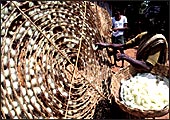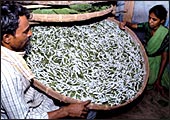 |
| White gold? Poor quality of cocoons
is a common lament among reelers at the auction house |
OCTOBER
10, 2006
11 a.m., Government Silk Market, Ramanagaram,
South Karnataka
On
the face of things, there shouldn't be any cause for concern over
the state of the local silk industry in Ramanagaram, a small town
on the congested Mysore Road, some 50 km from the bustling technopolis
that is Bangalore. The government-run silk market and auction
house is a beehive of activity, as farmers bring in their cocoons
and patiently wait for an auction to be completed and their produce
to be auctioned to reelers from the neighbouring localities. Assistants
sling large sacks of cocoons onto their heads and stagger out
of the market to nearby reeling units. It is estimated that some
50 tonnes of cocoons, valued at Rs 60 lakh, are traded every day
and more than 7,000 people (across farming, reeling, and other
operations) are employed in the local silk industry. Government
officials, including B.C. Kempegowda, the Deputy Director of Sericulture,
are quick to intercept this writer at the entrance of the silk
market, insisting on giving us (the photographer follows close
behind) a guided tour of this facility and "helping out"
with any other requirements.
 |
| Hard work and minimal returns: Many
reelers are reported to have moved to Bangalore or other jobs |
India currently is a distant second to China
in the global silk market, producing some 16,000 tonnes of silk
annually, with over 60 per cent of this amount coming from units
in Ramanagaram and other small towns in Karnataka. "Ramanagaram
is the silk capital of the country and this is the largest silk
market in Asia," Kempegowda says over a piping hot glass
of almond (badaam) milk in his corner office. Outside, however,
the mood is not so genial, as farmers and reelers claim that the
government is interfering too much with prices and facilities
are inadequate at this market. "The quality of cocoons is
very poor at this market, since farmers are greedy and want to
dump their produce in this market. You need at least a week for
the cocoons to mature, but they bring it here in two-three days
itself," says Pyaare Jaan, a local reeler. Farmers, however,
are quick to retaliate, contending that reelers and their buyers
lower prices, creating artificial surpluses or claiming that cocoons
are of inferior quality. "Prices can vary from Rs 130-140
per kg on one day to Rs 90-100 the next," says one aggrieved
farmer.
At Naalbanwadi Mohalla, the sense of discontent
is evident, with some former reelers reportedly reduced to daily
wage earners in Bangalore and others resorting to running kiraana
stores or scrap yards. "We would like the government to take
a more active role to help the industry," says one farmer.
Government officials admit that as larger towns such as Bangalore
and Mysore offer more lucrative opportunities, an involuntary
migration seems inevitable.
|
|
| The government view: Kempegowda (above)
blames the recession on failed monsoon |
 |
 |
Kempegowda, however, insists that the government
has a handle on things and hasn't let the situation spiral out
of control. "There was a recession two-three years ago when
the monsoons failed and the entire industry went through years
of struggle," he tells this correspondent as we walk through
the section selling pale yellow multivoltine grade, towards the
snow white (higher quality) bivoltine variety. An industry struggling
to recover from a near fatal recession over the last couple of
years (according to some unofficial estimates, 500 of the 2,000-odd
reelers in town shut shop) means that banks are saddled with debts
of at least Rs 5 crore and are unwilling to lend any more. "Reelers
over-stretched themselves four years ago and when the downturn
hit, many of them defaulted on their loans," an official
with the local State Bank of India branch claims. Because of these
defaults, many of the reelers have remained saddled with outdated
production equipment that has only widened the chasm between them
and their Chinese counterparts. "Ramanagaram is just about
managing to survive today, but urgently needs to upgrade to semi-automatic
or automatic reeling equipment and larger production facilities
to stay competitive," says M. Imitiaz Pasha, Proprietor of
SIM Silks and the President of the Local Reelers Association.
Aside from internal problems, Ramanagaram's
silk industry has been affected by dumping by Chinese manufacturers.
"Dumping has affected this industry tremendously over the
last 18-24 months and only the imposition of a stiff anti-dumping
tax has helped recently, since it brought prices to near parity,"
claims Kempegowda. The issue of dumping gets some high-profile
support, with Karnataka's Chief Minister and, incidentally, the
local MLA, H.D. Kumaaraswaamy, promising to lend a helping hand
to the industry. "Because of dumping by Chinese players,
our silk industry has been hit hard. My government is taking all
measures possible to help sericulturists, be they mulberry farmers,
silk twisters, yarn traders or silk producers," says Kumaaraswaamy.
Meanwhile, Kempegowda points out that expansion
and modernisation plans are afoot for the Ramanagaram Silk Market
and work will proceed as soon as the green signal is received.
"We have sent the government a Rs 50-crore development plan
for this market and hope to receive their approval soon,"
he claims. Part of this amount, will be used to expand the existing
auction space and to set up automated machines (on the lines of
an ATM) to deliver cash to farmers," says Kempegowda. While
the 5,000-year old silk industry has managed to rapidly convert
itself from a cottage industry into a large-scale operation, it
remains to be seen which silk route Ramanagaram's units take.
|









